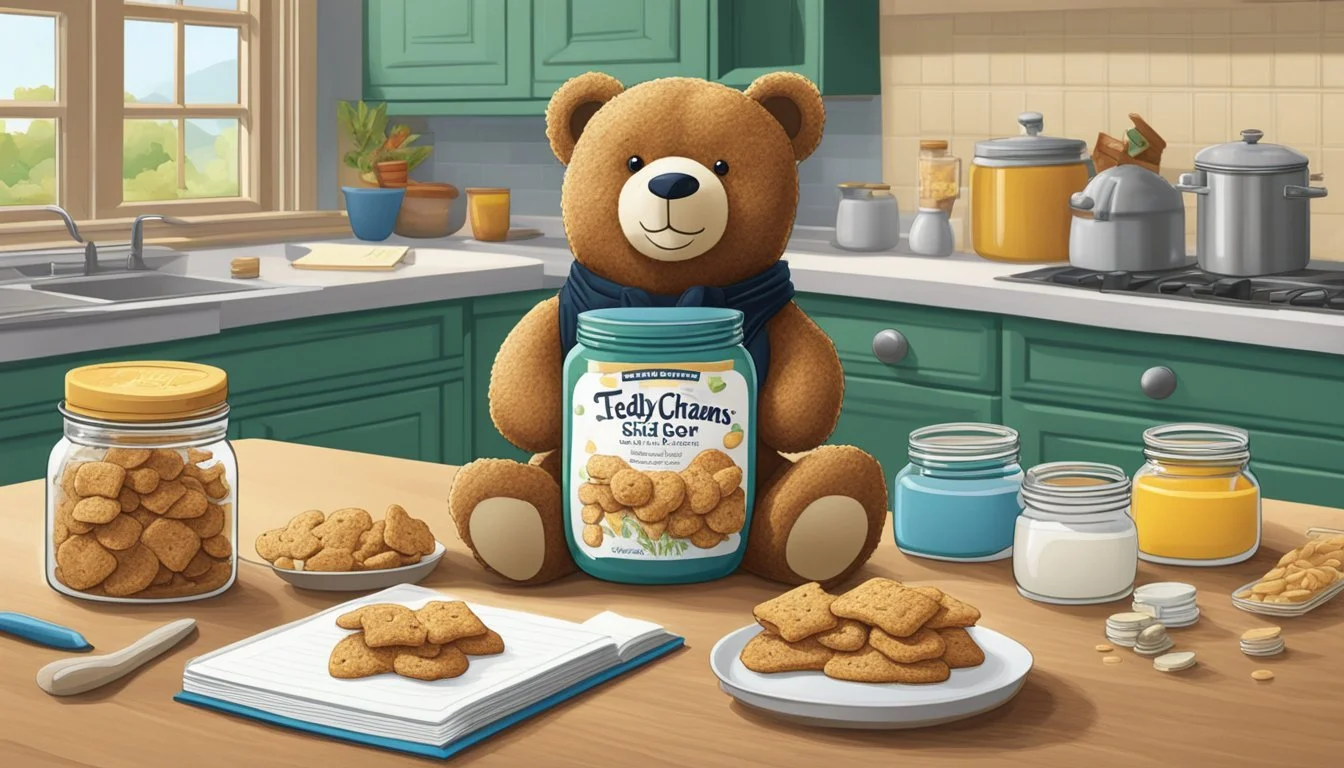How Long Do Teddy Grahams Last?
Shelf Life and Storage Tips
Teddy Grahams (how long do teddy grahams last?) are a popular snack item beloved by both children and adults for their playful shape and satisfying crunch. Introduced in 1988, these bite-sized graham cracker bears have become a staple snack in American households. Given their prepackaged convenience, consumers often purchase them in bulk, leading to questions about their shelf life and how to best preserve their freshness.
The shelf life of Teddy Grahams largely depends on storage conditions. When stored properly in a cool, dry place, an unopened package of Teddy Grahams can maintain quality for approximately 6 to 9 months. It's important to note that this time frame is an estimate for peak quality; the crackers may still be safe to consume beyond this period if they exhibit no signs of spoilage such as a stale smell or presence of mold.
Consumers should also consider that the shelf life can differ once the package is opened. Exposure to air, humidity, and other environmental factors can accelerate the process of staling, making the crackers less enjoyable to eat. As with many prepackaged snacks (What wine goes well with snacks?), using airtight containers or resealable bags after opening can help prolong freshness and viability for snacking.
Understanding Teddy Grahams
Teddy Grahams are a snack produced by Nabisco, offering a sweet taste and a distinctive bear shape that families have enjoyed since their introduction. Derived from the traditional graham cracker recipe, they are more than a simple snack, holding a rich history and incorporating principal ingredients that contribute to their unique flavor.
History and Origin
Teddy Grahams were introduced by Nabisco in 1988, enjoying immediate success with sales surpassing $150 million in the first year. They quickly became a staple snack, regarded as one of the industry's most significant new-product successes in over two decades. Tracing the lineage of Teddy Grahams leads back to the origins of graham crackers, which were conceptualized by Sylvester Graham in the early 1800s. Graham, an American dietary reformer, introduced graham flour with the intention to promote health.
Main Ingredients
The primary ingredient in Teddy Grahams is graham flour, a type of whole wheat flour (how long does whole wheat flour last?) that contains the endosperm, germ, and bran. This flour is named after Sylvester Graham and is a crucial component of classic graham crackers. The other key ingredients in Teddy Grahams include:
Flour: Provides structure and texture.
Sugar and Honey: Offer sweetness and contribute to the golden color.
Oil: Adds fat, which gives a tender crumb.
Vanilla, Chocolate, and Cinnamon: These flavors are commonplace, adding depth to the overall taste.
Salt: Enhances the flavors and balances sweetness.
Nabisco, now under the global snack company Mondelez International, ensures that these ingredients are combined to create products that are not only tasty but consistent in quality.
Varieties of Teddy Grahams
Teddy Grahams come in a range of flavors suited to different preferences, each offering a unique taste experience while maintaining the snack's characteristic crunchy texture.
Classic Flavors
Honey: A sweet and comforting flavor reminiscent of traditional graham crackers, honey Teddy Grahams are often a fan favorite.
Cinnamon: Infused with a warm, spicy note, the cinnamon variety adds an aromatic twist to the classic cracker.
Chocolate: Catering to chocolate lovers, this variety carries a rich cocoa taste without overshadowing the graham cracker essence.
Chocolatey Chip: Incorporating tiny chocolate chips, this flavor offers a textural contrast with bursts of chocolate in every bite.
Limited Editions
Birthday Cake: Previously released as a limited-time flavor, Birthday Cake Teddy Grahams featured a taste similar to vanilla cake with festive sprinkles.
Nutritional Variation
Gluten-Free Options: While traditional Teddy Grahams contain wheat, alternative gluten-free products cater to those with dietary restrictions.
Vegan Varieties: Certain flavors align with vegan diets, though it's crucial to verify individual product labels for specific dietary compliance.
Nutritional Content: Typically, Teddy Grahams provide carbohydrates for energy, with varying levels of fat, sodium, and protein. They contain small amounts of calcium and iron, contributing to daily nutritional intake.
Shelf Life and Storage
Teddy Grahams, a popular snack, have varying shelf lives depending on their storage conditions. Maintaining freshness hinges on keeping these snacks in proper environments, which can either prolong or reduce their optimal consumption period.
Unopened Packages
Unopened packages of Teddy Grahams can remain at peak quality for 6 to 9 months when stored appropriately. To achieve this, one should place them in a cool, dry place, away from heat and moisture which can accelerate deterioration. After the best by date, the crackers might lose some of their crispness but are generally still safe to eat if they have been stored correctly and show no signs of spoilage.
Opened Packages
Once a package of Teddy Grahams is opened, its contents are best consumed within 2 to 3 weeks. To extend this period, transferring the crackers to an airtight container is advised, as it prevents exposure to air and moisture. Continued storage in a cool, dry environment remains important to maintain freshness.
Freezing Teddy Grahams
For long-term preservation, freezing is a viable option. Place Teddy Grahams in freezer-safe bags or containers, removing as much air as possible before sealing. They can be frozen for up to 3 months. While freezing can affect texture, it does not compromise safety. Defrosting should be done at room temperature to ensure the crackers return to their original crispness as closely as possible.
Food Safety and Spoilage
When considering the consumption of Teddy Grahams past their best by date, it is crucial to take into account both the potential of spoilage and the related health risks. Even though the dry and preservative nature of these crackers often leads to a longer shelf life, vigilance against spoilage is key.
Identifying Spoilage
Teddy Grahams, like many other processed foods, exhibit certain signs when they are no longer safe to eat. Observing physical changes can be the first indicator:
Discoloration: Any change in color, including darkening or the presence of white spots, might indicate mold growth.
Odor: A stale or off smell is a clear sign that the Teddy Grahams should be discarded.
Texture: Crackers that have become unusually soft or chewy have likely absorbed moisture and might harbor harmful bacteria.
The presence of mold specifically renders the crackers unsafe, as it can lead to foodborne illnesses if consumed.
Potential Health Risks
Consuming spoiled Teddy Grahams carries the risk of:
Food Poisoning: Consumption of crackers contaminated with harmful bacteria like Salmonella or E. coli can lead to food poisoning, with symptoms ranging from mild gastrointestinal discomfort to more severe conditions.
Allergic Reactions: Mold may produce substances that can trigger allergic reactions in some individuals.
To minimize the risk of consuming spoiled products, buyers should adhere to the expiration dates and opt for proper storage methods. While spoiled foods may not always cause harm, adhering to food safety guidelines ensures the prevention of unnecessary risks.
Consumption Recommendations
When consuming Teddy Grahams, individuals are encouraged to follow best practices for maintaining freshness and to indulge responsibly to account for their nutritional content.
Best Practices
To ensure Teddy Grahams retain their tasty and crunchy texture, they should be stored in a cool, dry area. Once opened, transferring them to an airtight container can help maintain their freshness. It's important to check the best-by date and examine the snack for any signs of spoilage prior to consumption.
Indulging Responsibly
Teddy Grahams are a snack that, while tasty, should be consumed in moderation due to their sugar content. Individuals should be mindful of their daily sugar intake and not indulge too frequently, balancing these snacks with healthier options to avoid unnecessary worry about their diet.
Creative Uses in Recipes
Teddy Grahams can be more than just a snack; they offer versatility in the kitchen. Crafted into various recipes or ingeniously used as toppings, these bite-sized cookies enhance both flavor and texture in many sweet treats.
Desserts and Toppings
In desserts, Teddy Grahams serve as both an ingredient and a finishing touch. They make an excellent substitute for graham cracker pie crusts due to their similar taste and texture. Crushed cookies can be combined with melted butter and pressed into a pie tin to create a unique base for cheesecakes or pie crusts. For a playful garnish, whole Teddy Grahams can be sprinkled on top of ice cream or added to sprinkles on cupcakes for a whimsical touch. When mixed with candy, chocolatey chips, and peanut butter, they transform into a delightful snack mix.
Topping Ideas:
Ice cream sundaes with Teddy Grahams and chocolate syrup
Cupcakes garnished with crushed cookies and colorful sprinkles
Apple slices dipped in peanut butter and coated with Teddy Graham crumbs
Homemade Versions
For those who prefer to bake from scratch, creating homemade Teddy Grahams allows for customization of flavors, including chocolate, apple, and banana. These homemade variants can be prepared using healthier ingredients or to cater to dietary restrictions. Skilled bakers can incorporate Teddy Grahams into candy pieces or embed them into chocolatey chip cookies for an added crunch. Rolling them into balls with peanut butter and other ingredients can produce no-bake energy bites suitable for all ages.
Homemade Recipe Highlights:
Teddy Graham-inspired energy balls with banana, oats, and peanut butter
Custom cookies using various ingredients like cinnamon or apple sauce for unique flavors
Decorative desserts with homemade Teddy Grahams dipped in chocolate
Cultural and Historical Impact
Teddy Grahams have not only become a staple snack but also left a significant mark on popular culture and raised awareness on health trends since their inception in the late 20th century.
Marketing and Pop Culture
Since the debut of Teddy Grahams in 1988, Nabisco has successfully integrated the graham cookie into the fabric of American snacking. Nabisco, initially known as the National Biscuit Company, positioned Teddy Grahams as a fun, bite-sized snack that immediately resonated with consumers. The cookies exceeded $150 million in sales in their first year alone, trailing behind giants like Chips Ahoy! and Oreo, also Nabisco products, in the cookie market.
Prominent features in TV shows like "The Simpsons" and "Saturday Night Live" have highlighted the snack's presence in pop culture. Additionally, special editions like Dizzy Grizzlies and Teddy Soft Bakes have been introduced, aligning with popular trends and children's preferences, sometimes in collaboration with franchises such as Disney.
Health Movements
In the 19th century, the original graham cracker, a creation of Reverend Sylvester Graham, was part of a health movement that sought to curb what he viewed as unhealthy urges with a bland diet, which included the namesake cereal. Times have changed, and Teddy Graham's entry into the market occurred amidst evolving attitudes towards food and health.
Food critic Marian Burros of The New York Times brought attention to trans fats in the early 2000s, urging consumers to become more aware of what they were eating. In response, snacks like Teddy Grahams have been reformulated over time to reduce or eliminate trans fats in compliance with health guidelines and consumer expectations, while maintaining the sweet taste that made them popular. The longevity and adaptability of Teddy Grahams are testaments to their ability to meet both cultural and health standards over time.







